2025 XCTF国际网络攻防联赛-SUCTF分站赛 Misc Writeup

|
| 题目附件下载:https://pan.baidu.com/s/12xlTPFG1QJ9OWIM_f4lKbA?pwd=s44r 提取码: s44r |
题目名称 SU_checkin
附件给了一个流量包,用过滤器过滤一下,发现只有流50的返回值是200
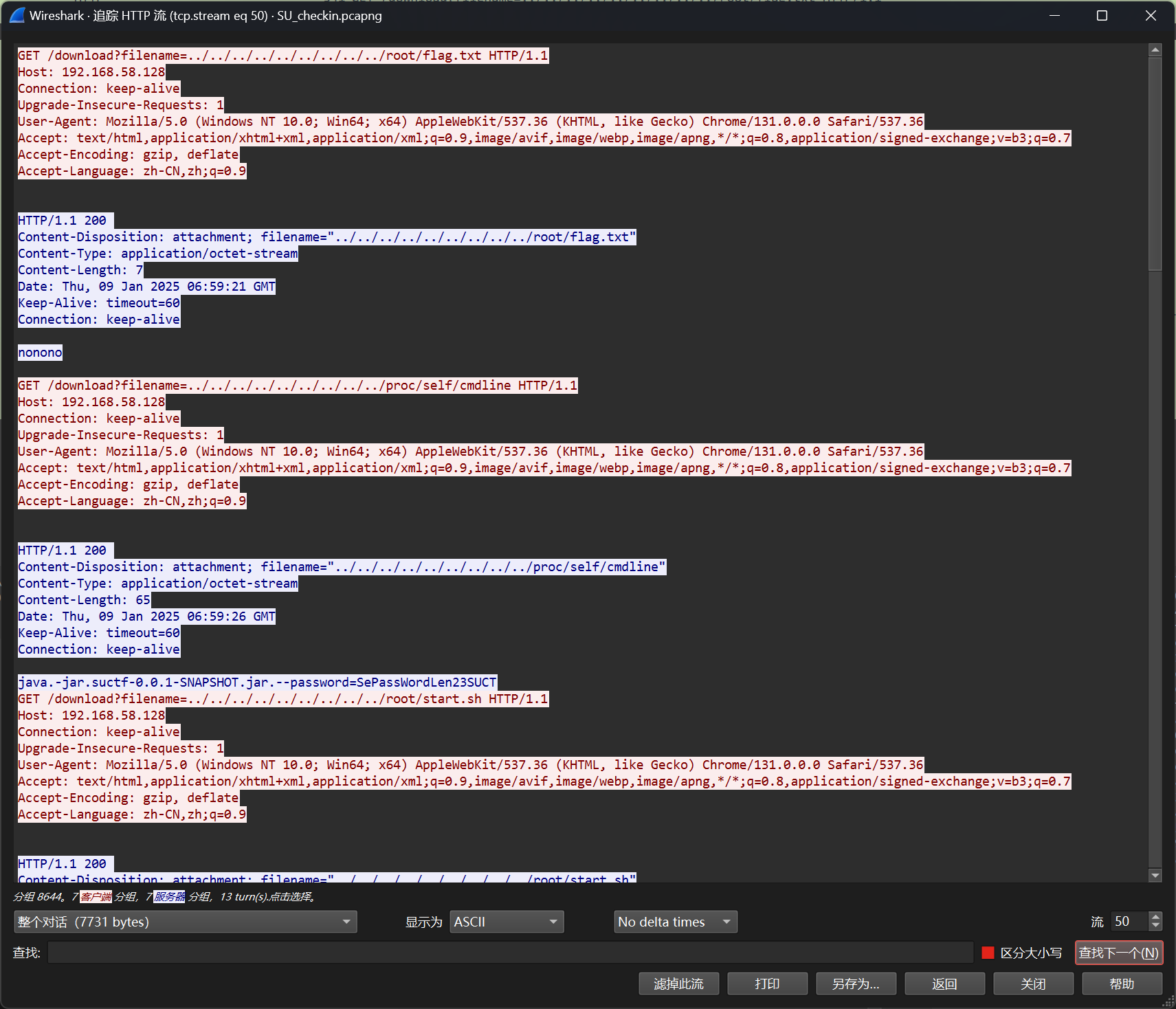
从上面的流量包中可以得到一下几个关键信息,密文、密钥以及加密算法
java.-jar.suctf-0.0.1-SNAPSHOT.jar.–password=SePassWordLen23SUCT
algorithm=PBEWithMD5AndDES
OUTPUT=ElV+bGCnJYHVR8m23GLhprTGY0gHi/tNXBkGBtQusB/zs0uIHHoXMJoYd6oSOoKuFWmAHYrxkbg=
但是仔细观察SePassWordLen23SUCT,发现密钥是不完整的并且提示了密钥长度是23
因此参考Github上这个PBEWithMD5AndDES解密脚本,爆破一下密钥即可
https://github.com/binsgit/PBEWithMD5AndDES/blob/master/python/PBEWithMD5AndDES_2.py
1
2
3
4
5
6
7
8
9
10
11
12
13
14
15
16
17
18
19
20
21
22
23
24
25
26
27
28
29
30
31
32
33
34
35
36
37
38
39
40
41
42
43
44
45
46
47
48
49
|
import base64
import hashlib
import re
import os
from Crypto.Cipher import DES
from string import printable
import itertools
def get_derived_key(password, salt, count):
key = password + salt
for i in range(count):
m = hashlib.md5(key)
key = m.digest()
return (key[:8], key[8:])
def decrypt(msg, password):
msg_bytes = base64.b64decode(msg)
salt = msg_bytes[:8]
enc_text = msg_bytes[8:]
(dk, iv) = get_derived_key(password, salt, 1000)
crypter = DES.new(dk, DES.MODE_CBC, iv)
text = crypter.decrypt(enc_text)
# print(text)
return text
def encrypt(msg, password):
salt = os.urandom(8)
pad_num = 8 - (len(msg) % 8)
for i in range(pad_num):
msg += chr(pad_num)
(dk, iv) = get_derived_key(password, salt, 1000)
crypter = DES.new(dk, DES.MODE_CBC, iv)
enc_text = crypter.encrypt(msg)
return base64.b64encode(salt + enc_text)
def main():
table = printable[:62]
for a, b, c in itertools.product(table, repeat=3):
passwd = "SePassWordLen23SUCTF{}{}{}".format(a, b, c)
print(passwd)
s = "ElV+bGCnJYHVR8m23GLhprTGY0gHi/tNXBkGBtQusB/zs0uIHHoXMJoYd6oSOoKuFWmAHYrxkbg="
res = decrypt(s, passwd)
# print(res)
if "SUCTF" in res:
print(passwd,res)
break
if __name__ == "__main__":
main()
|
python2运行以上脚本即可得到密钥和flag:SePassWordLen23SUCTF666 SUCTF{338dbe11-e9f6-4e46-b1e5-eca84fb6af3f}
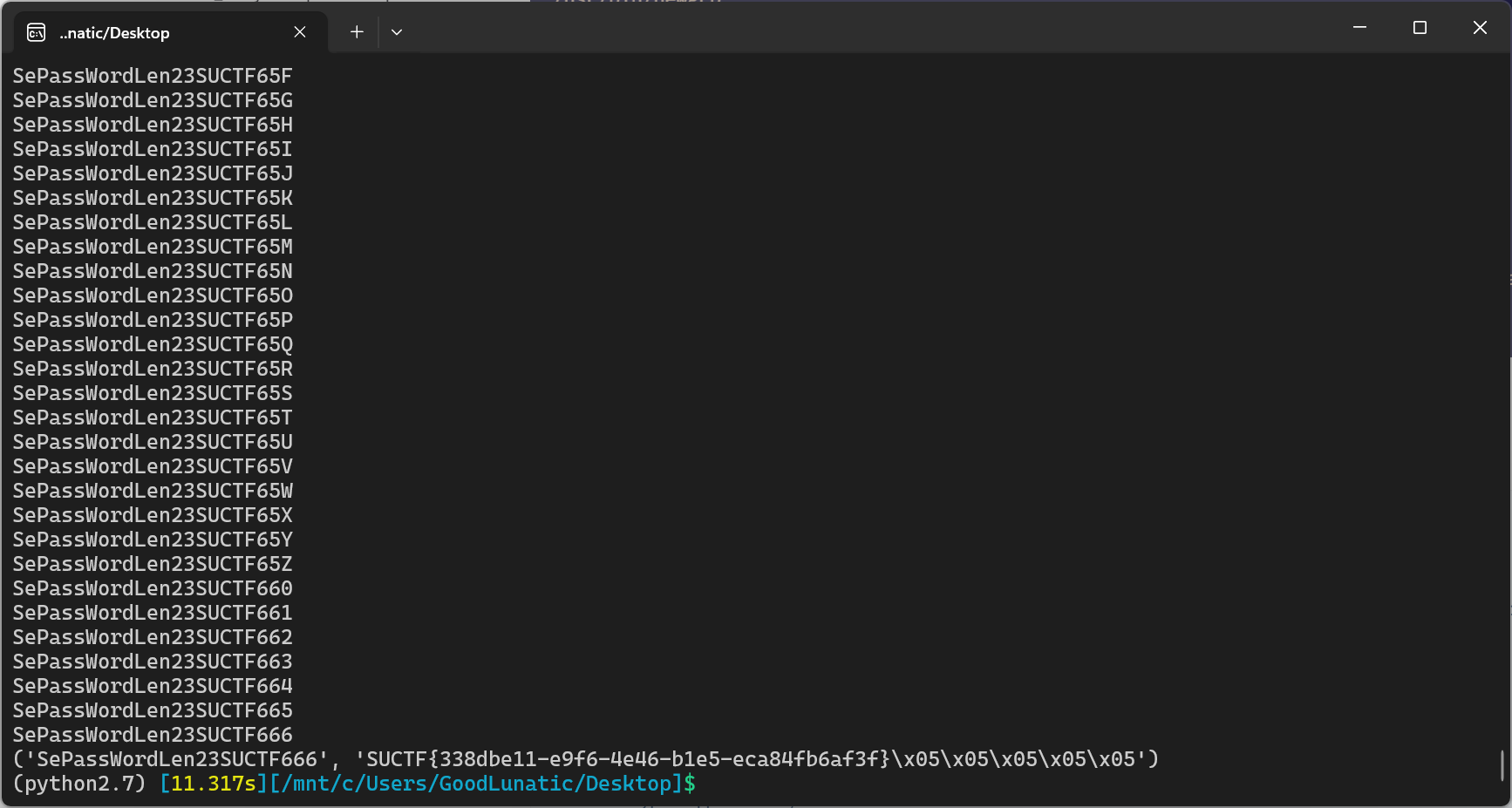
题目名称 SU_RealCheckin
给了个对应表,对应的字母其实就是emoji英文的首字母
hello ctf -> 🏠🦅🍋🍋🍊 🐈🌮🍟
$flag -> 🐍☂️🐈🌮🍟{🐋🦅🍋🐈🍊🏔️🦅🌮🍊🐍☂️🐈🌮🍟🧶🍊☂️🐈🍎🌃🌈🦅🍎🍋🍋🧶🐬🍎🌃🐈🦅}
签到题,写脚本其实没有手搓快。。。
1
2
3
4
5
6
7
8
9
10
11
12
13
14
15
16
17
18
19
20
21
22
23
24
25
26
27
28
29
30
|
flag = "🐍☂🐈🌮🍟{🐋🦅🍋🐈🍊🏔️🦅_🌮🍊_🐍☂️🐈🌮🍟_🧶🍊☂️_🐈🍎🌃_🌈🦅🍎🍋🍋🧶_🐬🍎🌃🐈🦅}"
dic = {
'🏠':'h',
'🦅':'e',
'🍋':'l',
'🍊':'o',
'🐈':'c',
'🌮':'t',
'🍟':'f',
'🐍':'s',
'☂️':'u',
'🐋':'w',
'🏔️':'m',
'🧶':'y',
'🌈':'r',
'🌃':'n',
'🍎':'a',
'🐬':'d'
}
for item in flag:
if item == '_' or item == '{' or item == '}':
print(item,end='')
else:
try:
print(dic[item],end='')
except:
print(" ",end='')
# s ctf{welco e_to_s ctf_yo _can_really_dance}
# suctf{welcome_to_suctf_you_can_really_dance}
|
题目名称 SU_forensics
狗and猫师傅出的题,整体思路是挺好的,质量也很高,就是最后一步的字频爆破,不给提示还是难以联想
题面信息如下:
bkfish在自己的虚拟机里运行了某些命令之后用"sudo reboot"重启了主机,接着他按照网上清除入侵记录的方法先"rm -rf .bash_history"然后"history -c"删除了所有的命令记录。在现实世界中,消失的东西就找不回来了,但在网络世界里可未必如此,你能找到bkfish消失的秘密吗?
flag提交格式:全大写的SUCTF{XXXX}
附件直接给了Vmware虚拟机的所有文件,Vmware可以直接打开.vmx文件
但是进入系统需要密码,系统版本是Ubuntu14.04LTS
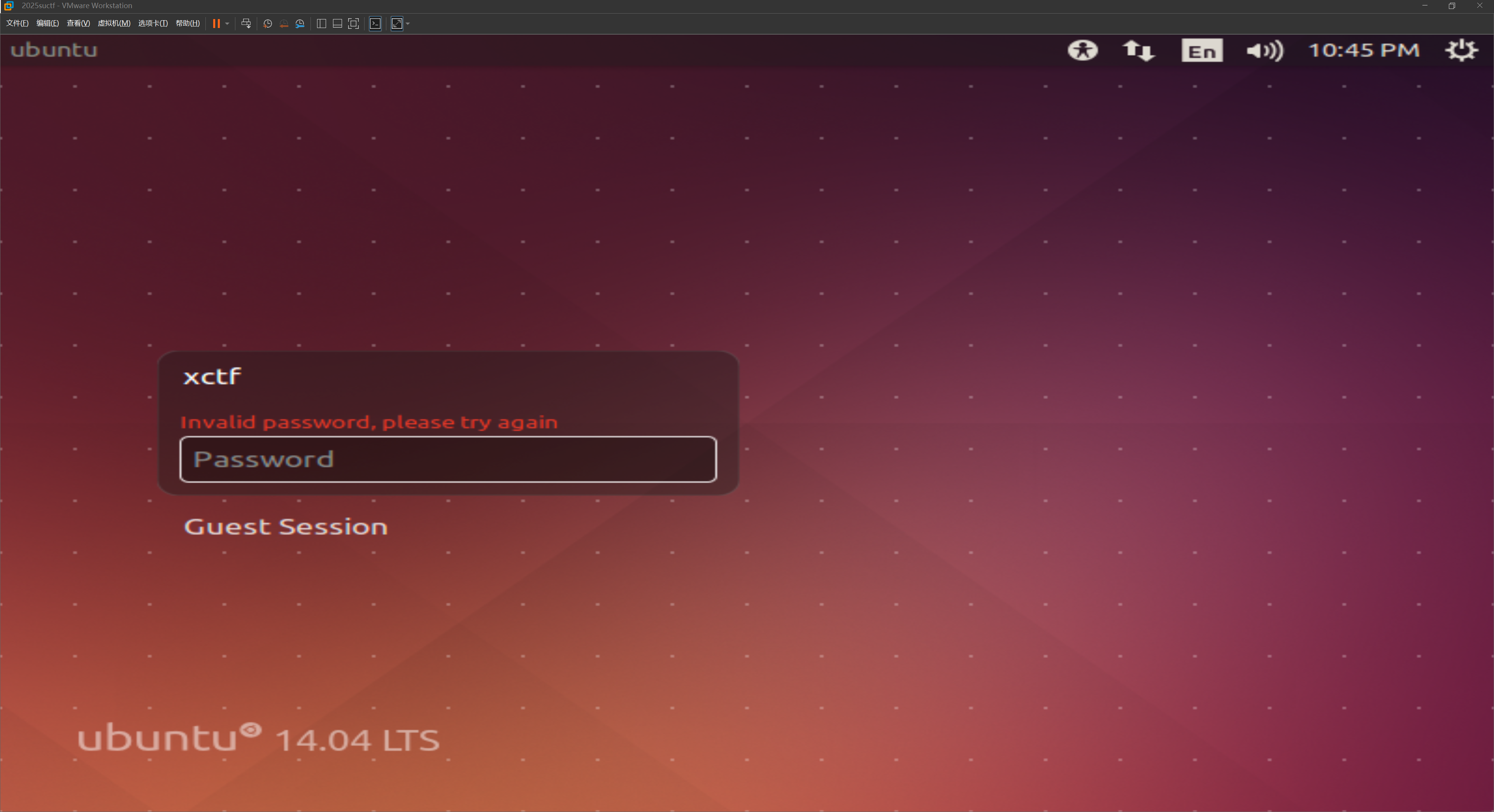
可以直接用DiskGenius挂载vmdx虚拟磁盘文件
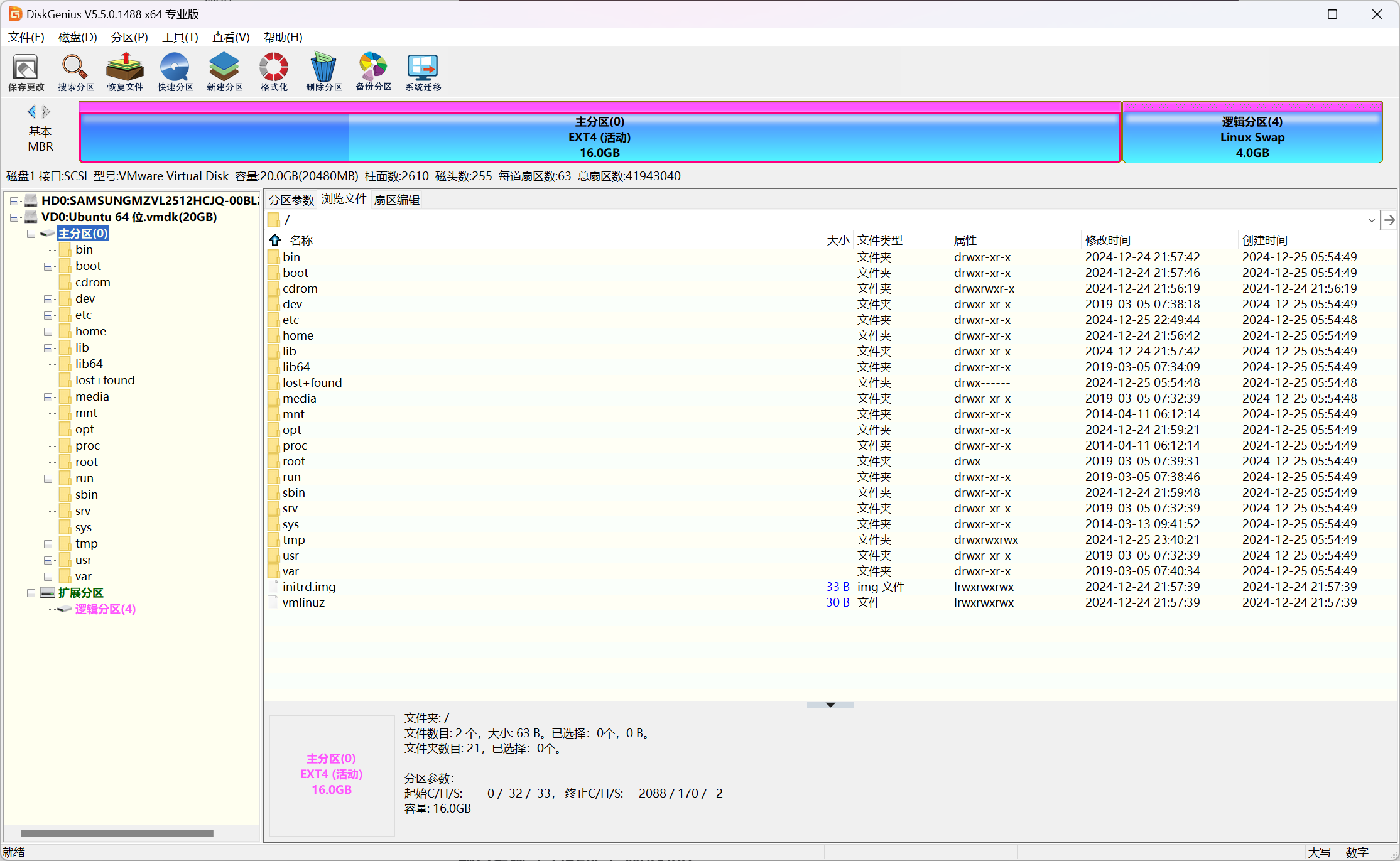
然后尝试使用DiskGenius的恢复数据功能,可以恢复出被删除的.bash_history
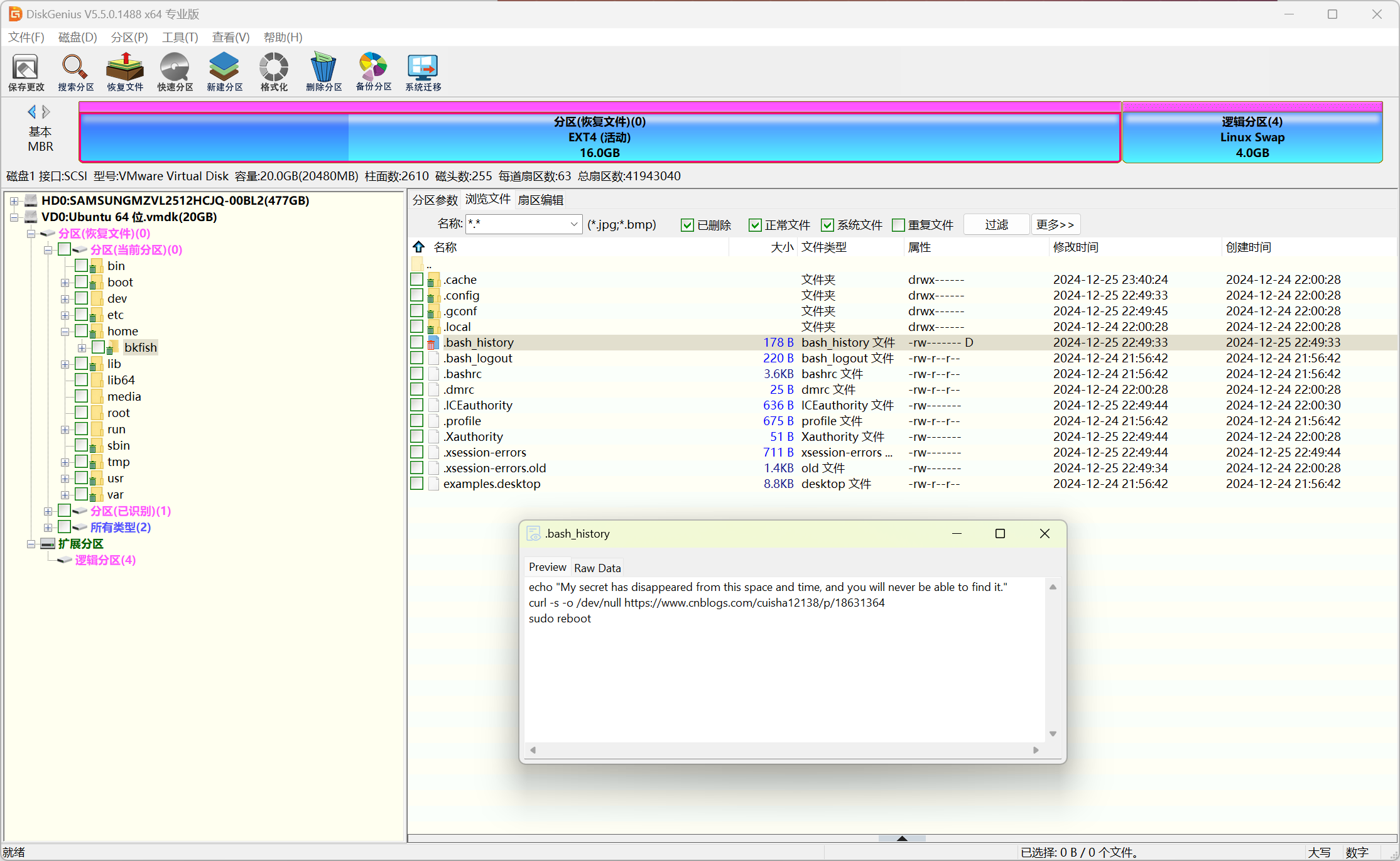
.bash_history内容如下
echo “My secret has disappeared from this space and time, and you will never be able to find it.”
curl -s -o /dev/null https://www.cnblogs.com/cuisha12138/p/18631364
sudo reboot
访问里面那个博客园的链接,发现已经被删除了,但是我们可以尝试去网站时光机上找一找
网站时光机的链接:https://web.archive.org/
这篇被删除的文章的链接:https://web.archive.org/web/20241225122922/https://www.cnblogs.com/cuisha12138/p/18631364
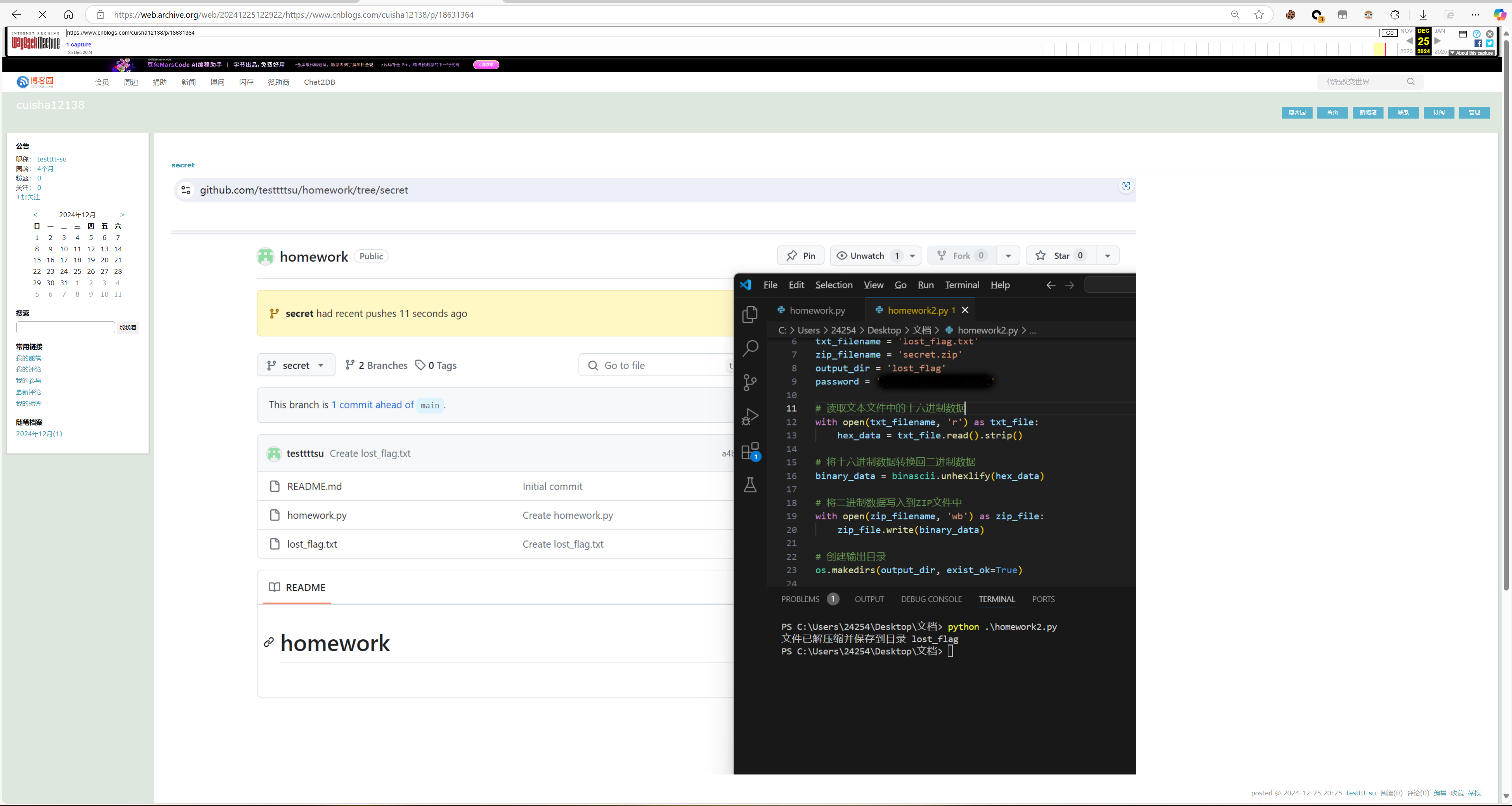
文章中的图片提示了我们一个Github的仓库:https://github.com/testtttsu/homework
并且通过提高图片的亮度和对比度我们可以得到解压密码:2phxMo8iUE2bAVvdsBwZ
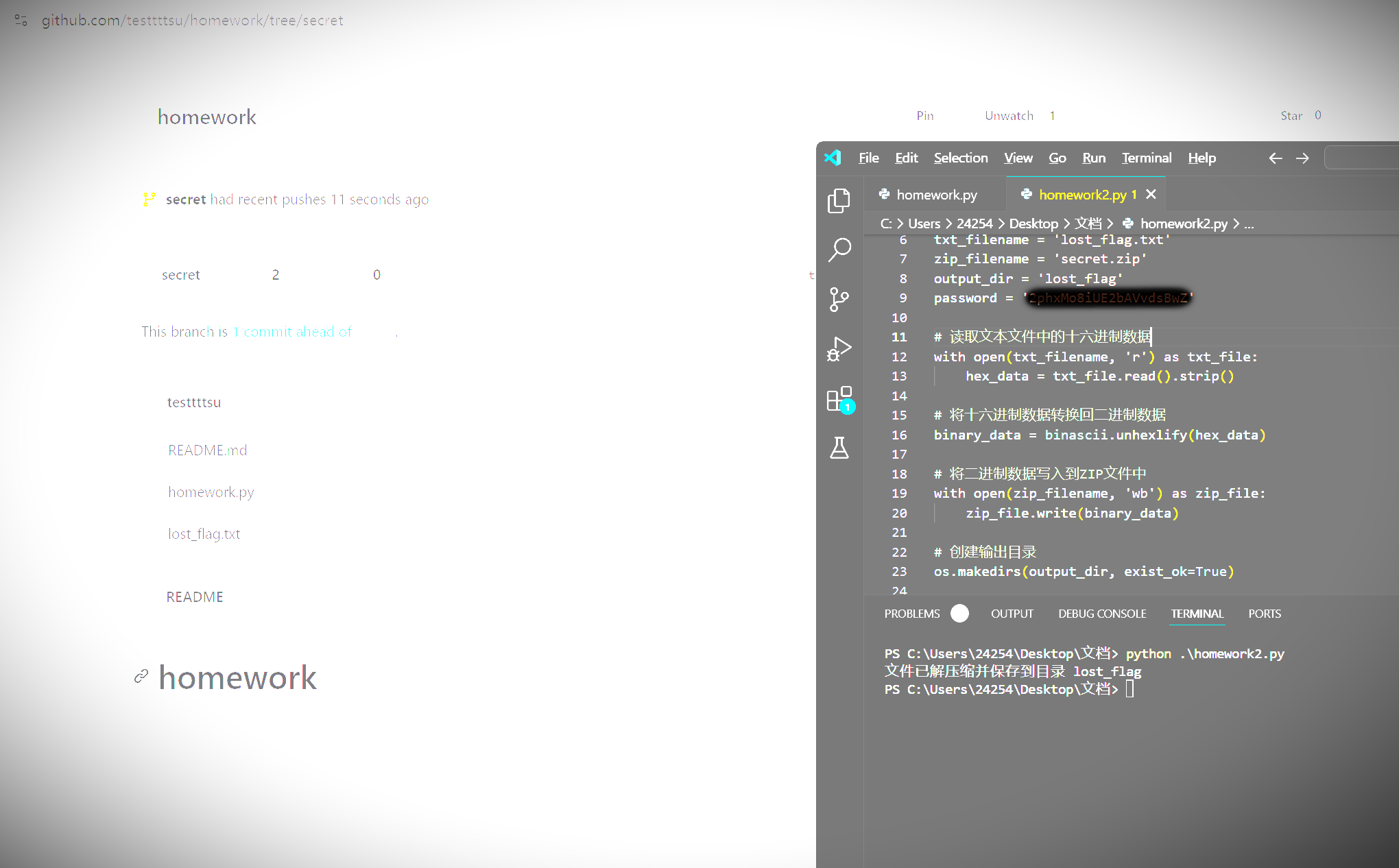
我们访问上面的那个Github仓库,发现这个分支已经被删除了

但是我们可以从旁边的activity中找到这个被删除的文件

然后填上之前得到的解压密码,用仓库中的脚本直接运行即可得到下面这张图片

写了个脚本来分割图片,并统计每种符号出现的次数
1
2
3
4
5
6
7
8
9
10
11
12
13
14
15
16
17
18
19
20
21
22
23
24
25
26
27
28
29
30
31
32
33
34
35
36
37
38
39
40
41
42
43
44
45
46
47
48
49
50
51
52
53
54
55
56
57
58
59
60
61
62
63
64
65
66
67
68
69
70
71
72
73
74
75
76
77
78
79
80
81
82
83
84
85
86
87
|
from PIL import Image
import hashlib
import os
def crop_table():
if os.path.exists("out"):
print("[+] out 目录已存在")
else:
os.mkdir("out")
print("[+] out 目录创建成功")
img = Image.open("1.png")
width, height = img.size # 9522, 1296
print(f"图片尺寸: {width}x{height}")
crop_width = 137
crop_height = 107
cols = (width - 0) // crop_width
rows = (height - 0) // crop_height
print(f"可分割的列数: {cols}, 行数: {rows}")
index = 1
for row in range(rows):
for col in range(cols):
# 计算裁剪区域的坐标
left = 0 + col * (crop_width + 1)
upper = 0 + row * (crop_height + 1)
right = left + crop_width
lower = upper + crop_height
cropped_img = img.crop((left, upper, right, lower))
cropped_img.save(f"out/{index}.png")
print(f"[+] out/{index}.png 保存成功 (区域: {left},{upper} -> {right},{lower})")
index += 1
def calculate_md5(filename):
# 计算文件的 MD5 值
hasher = hashlib.md5()
with open(filename, 'rb') as f:
for chunk in iter(lambda: f.read(4096), b""):
hasher.update(chunk)
return str(hasher.hexdigest())
if __name__ == "__main__":
# crop_table()
dic = {}
for i in range(1,829):
filename = f"./out/{i}.png"
tmp_hash = calculate_md5(filename)
if tmp_hash not in dic:
dic[tmp_hash] = 1
else:
dic[tmp_hash] += 1
print(dic)
# {'a92114d80fb8d9f051267093ff31f652': 35,
# '643a1412425e02202bc739ed381fc2ce': 104,
# 'c2ba6829d6b89fe4d95f59143f5dab09': 12,
# '0ea52827f2cd163ec0abd5c138bd8d52': 24,
# '6cfc1169ffd57fcccf6c9deb2c9b8a81': 50,
# 'a733e9655b25c318db40ee3e4e6fc9b7': 14,
# '78ea7aa8bad5966f51d34ce68f9bb1a4': 15,
# '274d11fd91b261ea9a4dfbfcfccc5caf': 13,
# '0b27aed76fc735518d8400ec44888b17': 44,
# '345cfeee944eff97baecafc30f998be8': 13,
# 'a54cbc7076fe3385ec19e5844ede06d8': 16,
# '01288ae944ad4fa589fa7f8c8921c6db': 19,
# 'd3b493d9622e43c2fd0932cbc8eb4242': 24,
# '09298a31ed656279970cbdb61e220fce': 13,
# '5650d4328599806e228163b9f3883b76': 23,
# '902d339e136a450f8dcf5912acf3908b': 29,
# 'ec3995e91d6770d86f31c91fb9f1f18c': 15,
# 'd3405ba0628f6c5a7847172b75c96e24': 13,
# '97071255bca34a123d21c8077326e849': 12,
# '463a505a8bde3e32d3215ac582545ade': 24,
# '2c5eeaa83376135696cdf14ee2e65527': 17,
# '972487ddb0c7427f86244525c765ceb1': 21,
# 'b656951ad9063e1e714eb5066e355043': 13,
# '6f891cd850e8e2e75ca95565793730a5': 28,
# '8b4bc073bc7a2526cf3b197537c8d299': 12,
# '87b5f6ccfa6d7c9c733b1c665fb138ca': 14,
# '100dfaec51061f9d69ecbbfa87d0ef3d': 179,
# '279a7e86da10953b77671a3cacf8b087': 32}
|
发现除掉黑色的背景后一共27字符,因此猜测是26个字符+空格
我们不去管每种字符的对应方式,出现次数最多的字符肯定是空格,因此我们先随意做一个对照表
然后根据对照表生成图片中表示的密文,具体脚本如下:
1
2
3
4
5
6
7
8
9
10
11
12
13
14
15
16
17
18
19
20
21
22
23
24
25
26
27
28
29
30
31
32
33
34
35
36
37
38
39
40
41
42
43
44
45
46
47
48
49
50
51
52
53
54
55
56
57
58
59
60
61
62
63
|
from PIL import Image
import hashlib
import os
table = {'a92114d80fb8d9f051267093ff31f652': 'A', '643a1412425e02202bc739ed381fc2ce': ' ', 'c2ba6829d6b89fe4d95f59143f5dab09': 'B', '0ea52827f2cd163ec0abd5c138bd8d52': 'C', '6cfc1169ffd57fcccf6c9deb2c9b8a81': 'D', 'a733e9655b25c318db40ee3e4e6fc9b7': 'E', '78ea7aa8bad5966f51d34ce68f9bb1a4': 'F', '274d11fd91b261ea9a4dfbfcfccc5caf': 'G', '0b27aed76fc735518d8400ec44888b17': 'H', '345cfeee944eff97baecafc30f998be8': 'I', 'a54cbc7076fe3385ec19e5844ede06d8': 'J', '01288ae944ad4fa589fa7f8c8921c6db': 'K', 'd3b493d9622e43c2fd0932cbc8eb4242': 'L', '09298a31ed656279970cbdb61e220fce': 'M', '5650d4328599806e228163b9f3883b76': 'N', '902d339e136a450f8dcf5912acf3908b': 'O', 'ec3995e91d6770d86f31c91fb9f1f18c': 'P', 'd3405ba0628f6c5a7847172b75c96e24': 'Q', '97071255bca34a123d21c8077326e849': 'R', '463a505a8bde3e32d3215ac582545ade': 'S', '2c5eeaa83376135696cdf14ee2e65527': 'T', '972487ddb0c7427f86244525c765ceb1': 'U', 'b656951ad9063e1e714eb5066e355043': 'V', '6f891cd850e8e2e75ca95565793730a5': 'W', '8b4bc073bc7a2526cf3b197537c8d299': 'X', '87b5f6ccfa6d7c9c733b1c665fb138ca': 'Y', '279a7e86da10953b77671a3cacf8b087': 'Z'}
def calculate_md5(filename):
# 计算文件的 MD5 值
hasher = hashlib.md5()
with open(filename, 'rb') as f:
for chunk in iter(lambda: f.read(4096), b""):
hasher.update(chunk)
return str(hasher.hexdigest())
def get_text():
if os.path.exists("out"):
print("[+] out 目录已存在")
else:
os.mkdir("out")
print("[+] out 目录创建成功")
img = Image.open("1.png")
width, height = img.size # 9522, 1296
print(f"图片尺寸: {width}x{height}")
crop_width = 137
crop_height = 107
cols = (width - 0) // crop_width
rows = (height - 0) // crop_height
print(f"可分割的列数: {cols}, 行数: {rows}")
index = 1
text = ""
for row in range(rows):
for col in range(cols):
# 计算裁剪区域的坐标
file_path = f"out/{index}.png"
left = 0 + col * (crop_width + 1)
upper = 0 + row * (crop_height + 1)
right = left + crop_width
lower = upper + crop_height
cropped_img = img.crop((left, upper, right, lower))
cropped_img.save(file_path)
hash_value = calculate_md5(file_path)
print(hash_value)
if hash_value == "100dfaec51061f9d69ecbbfa87d0ef3d":
text += '\n'
break
else:
text += table[hash_value]
if col == cols-1:
text += '\n'
print(f"[+] out/{index}.png 保存成功 (区域: {left},{upper} -> {right},{lower})")
index += 1
return text
if __name__ == "__main__":
text = get_text()
print(text)
|
运行以上脚本后可以得到如下内容
A BCDEF GHIJKL MNOP QHRDST UAVW XDY
VLHU ZIHEDANDGHU DS WJH XOM OV YAFDST QHLK BAMANDZWDE PAR WOKZ
ZDR VLHSGDHU FDSTZ QOPHU WO AMONDZJ YK BCDWH IDWDVCN XOCZWZ
YAK XO HBCAN YK VOONDZJ LHEOLU MK ZONQDST ZDR ICGGNHZ A PHHF
JALLK DZ XOTTDST BCDEFNK PJDEJ ARHU GHS YOSFZ PDWJ AMCSUASW QAIOL
UCYIK FDMDWGHL XDSTNHZ AZ BCDROWDE OQHLVNOPZ
SKYIJ ZDST VOL BCDEF XDTZ QHR MCU DS GHZWVCN WPDNDTJW
ZDYINH VOR JHNU BCALWG UCEF XCZW MK PDST
ZWLOST MLDEF BCDG PJASTZ XCYIK VOR QDQDUNK
TJOZWZ DS YHYOLK IDEFZ CI BCALWG ASU QANCAMNH OSKR XHPHNZ
IHSZDQH PDGALUZ YAFH WORDE MLHP VOL WJH HQDN BAWALD FDST ASU PLK XAEF
ANN OCWUAWHU BCHLK AZFHU MK VDQH PAWEJ HRIHLWZ AYAGHU WJH XCUTH
这个东西看起来很眼熟对吧,很容易就能想到quipquip字频爆破

爆破后可以得到如下内容
A QUICK ZEPHYR BLOW VEXING DAFT JIM
FRED SPECIALIZED IN THE JOB OF MAKING VERY QABALISTIC WAX TOYS
SIX FRENZIED KINGS VOWED TO ABOLISH MY QUITE PITIFUL JOUSTS
MAY JO EQUAL MY FOOLISH RECORD BY SOLVING SIX PUZZLES A WEEK
HARRY IS JOGGING QUICKLY WHICH AXED ZEN MONKS WITH ABUNDANT VAPOR
DUMPY KIBITZER JINGLES AS QUIXOTIC OVERFLOWS
NYMPH SING FOR QUICK JIGS VEX BUD IN ZESTFUL TWILIGHT
SIMPLE FOX HELD QUARTZ DUCK JUST BY WING
STRONG BRICK QUIZ WHANGS JUMPY FOX VIVIDLY
GHOSTS IN MEMORY PICKS UP QUARTZ AND VALUABLE ONYX JEWELS
PENSIVE WIZARDS MAKE TOXIC BREW FOR THE EVIL QATARI KING AND WRY JACK
ALL OUTDATED QUERY ASKED BY FIVE WATCH EXPERTS AMAZED THE JUDGE
仔细观察这个格式可以想到一个比较经典的Pangram(全字母句子):The quick brown fox jumps over the lazy dog
因此把每一行中缺少的那个字母组合起来即可得到最后flag:SUCTF{HAVEFUN}
题目名称 SU_AD
参考链接:
https://z3n1th1.com/2025/01/suctf2025-writeup/#su_voip
https://kcno7cq8euks.feishu.cn/wiki/PKx0w2LrtiVo99k3tEDc0xBnnre
https://jk64eb0pjs.feishu.cn/docx/O6OUd1iSro8XcpxlpDAc0si5n5e
题目名称 SU_VOIP












 Lunatic
Lunatic